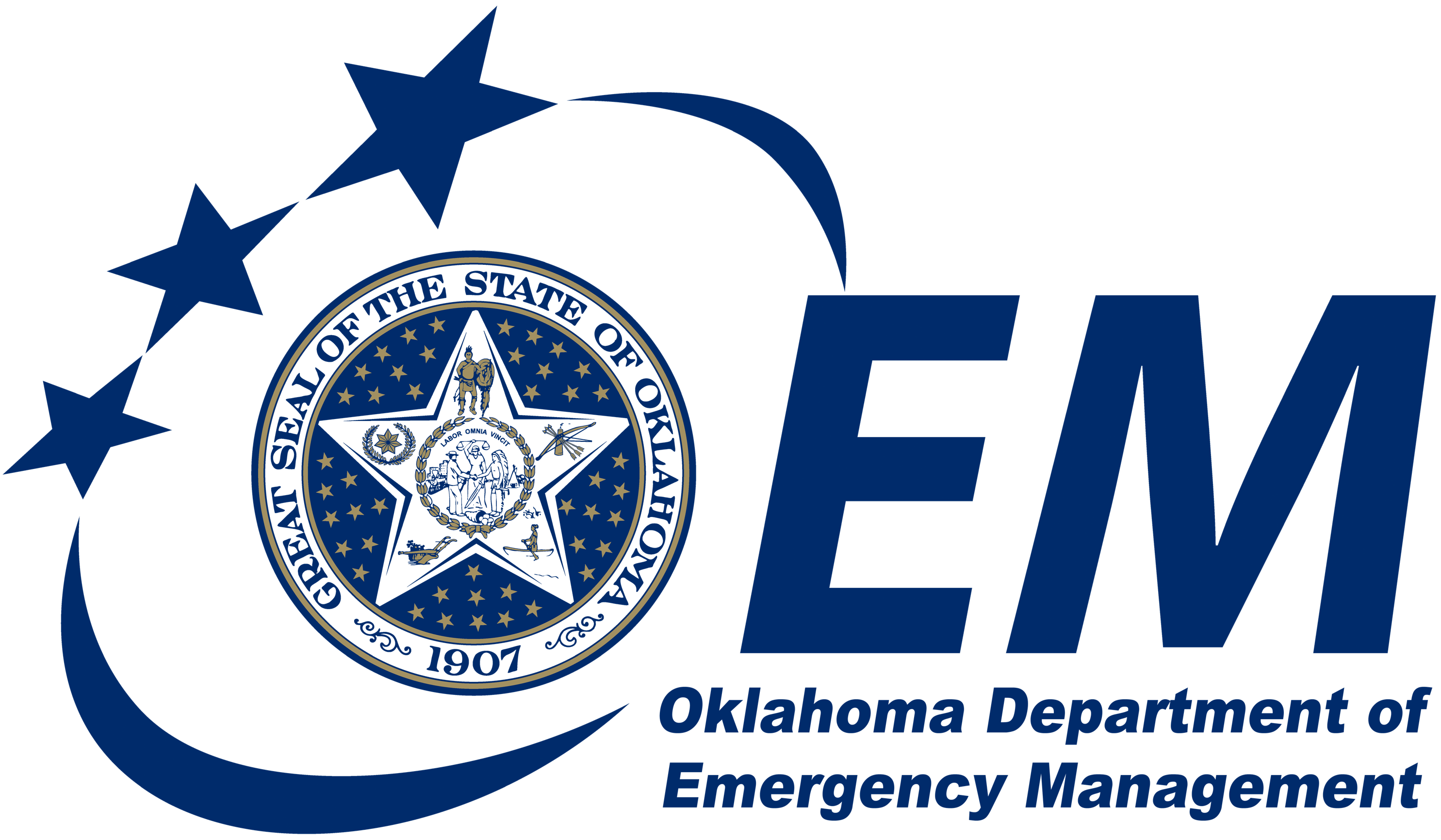Situation Update
Oklahoma Department of Emergency Management
Situation Update 2
December 24, 2009 – 9 p.m.
LIFE THREATENING WINTER STORM CONTINUES
Oklahoma remains under a State of Emergency, as declared by Gov. Brad Henry. The executive order marks a first step toward seeking federal assistance should it be necessary. Additionally, the order allows state agencies to make emergency purchases and acquisitions needed to expedite the delivery of resources to local jurisdictions.
The Governor, along with state emergency management, public safety and transportation officials, continues to discourage all travel. Travel throughout the state is discouraged. Please don’t travel unless it is an emergency. If motorists get stranded it may be hours before anyone can get to them.
Officials with the Oklahoma Department of Emergency Management (OEM) remain in contact with emergency managers in the affected areas.
WEATHER CONDITIONS
Blizzard warnings continue for much of central Oklahoma until 10 p.m., northeast areas of the state until 6 a.m. and Payne, Lincoln, Seminole, and Pottawatomie counties until 2 a.m. A Winter Storm Warning is in effect for far north-central and southeast Oklahoma until 2 a.m.
Travel is impossible across most of the state. Bitter temperatures have moved into Oklahoma along with very strong winds. Temperatures will remain below freezing for several days setting up a dangerous and prolonged cold period. Winds should decrease by morning. All precipitation should be out of the state by late morning Friday.
RESOURCE COORDINATION
Oklahoma National Guard personnel have been deployed to help stranded motorists on Oklahoma turnpikes and Interstates. Guard personnel have already assisted motorists on HE Bailey Turnpike. The Oklahoma Highway Patrol (OHP) continues to respond to numerous crashes and the Oklahoma Department of Transportation (ODOT) continues to treat slick and hazardous roadways.
There are no other requests for state assistance at this time. Industrial size generators are pre-staged around the state and can be deployed if necessary. These generators are NOT for households but rather for municipal water treatment plants or shelter operations should power outages require. OEM is standing by to deploy any other necessary resources as needed.
ROAD CONDITIONS
OHP reports the HE Bailey and Turner turnpikes are closed. Additionally, all interstates are closed throughout the state.
ODOT reports driving conditions continue to deteriorate in the eastern part of the state although snow storms have subsided in the western part of the state. Although crews are encouraged by weather improvements in western counties, travel is still discouraged due to blowing show and icy conditions. In far western counties, significant drifting is a problem. The interstate system in Oklahoma City remains gridlocked by numerous collisions.
Motorists who are stranded in their autos are advised to run the engine intermittently to conserve fuel while keeping warm and to open a window slightly to provide fresh air. Emergency crews report difficulty in reaching stranded motorists and advise that in many cases, rescues will take several hours.
Even though visibility has improved in central and western Oklahoma, wind and blowing snow continue to be a problem. Although ODOT crews will continue to work around the clock until roadways are cleared, a layer of ice under the snow will significantly slow recovery efforts.
To check CURRENT ROAD CONDITIONS, call the Oklahoma Department of Public Safety's ROAD CONDITIONS HOTLINE at 888-425-2385.
For out of state road conditions:
Arkansas 800-245-1672;
Colorado 303-639-1111;
Kansas 866-511-5368;
Missouri 800-222-6400;
New Mexico 800-432-4269;
and Texas 800-452-9292.
For anyone who must travel, remember to have a cell phone with a charged battery. Travel with a full tank of gas, blankets, water and other items required should you find yourself stranded awaiting a tow truck or first responders. Let others know your destination and the route you plan on traveling. Also, remember porches, parking lots and driveways are also extremely slick and hazardous.
POWER OUTAGES
The Corporation Commission reports about 9,500 homes and businesses are without power due to the winter storm. This includes:
The Oklahoma Association of Electric Cooperatives reports about 1,500 customers without power, including:
Caddo Electric Cooperative, Binger: Less than 250 outages
Cimarron Electric Cooperative, Kingfisher: 2 outages
Cookson Hills Electric Cooperative, Stigler:70 outages
Kiamichi Electric Cooperative, Wilburton: Less than 15 consumer-outages
Kiwash Electric Cooperative, Cordell: Less than 50 consumer-outages
Oklahoma Electric Cooperative, Norman: Less than 50 consumer-outages
Rural Electric Cooperative, Lindsay: Less than 25 outages
Southwest Rural Electric Association, Tipton: Approximately 500 consumer-outages remain, mostly in the Tipton and Navajo substation areas.
Northeast Oklahoma Electric Cooperative, Vinita: Less than 25 consumer-outages remain.
OG&E reports 3,878 customers without service including 3,630 in the Oklahoma City metro area.
AEP/PSO reports about 4,100 customers are without power. This includes 2,600 in Lawton southwest areas and 1,500 in the Tulsa area.
AIR TRAVEL
Officials with Will Rogers World Airport report the airport is closed. Most of today’s flights had to be cancelled due to the winter weather.
HUMAN SERVICES
EMSA continues to respond to medical emergency calls. Today they have responded to more than 100 calls for injury crashes and slips and falls related to the hazardous winter weather conditions.
The American Red Cross has opened the following shelters for stranded motorists looking for respite.
Lawton:Lawton High School, 601 NW Ft. Sill Blvd.
El Reno:Redlands Community College, 1300 South Country Club Road.
Norman:Journey Church, 1-35 and Tecumseh Road.
Stranded motorists seeking shelter are encouraged to call 1-866-GET-INFO to register as safe and well. Loved ones can search for individuals they are looking for by calling 1-866-GET INFO or online at the Reunification of Family American Red Cross page.
The Red Cross is also assisting with a shelter in Chickasha at Bible Baptist Church, 226 S. 29th Street.
Shelters are also open in Newcastle at the city storm shelter, 851 N. Carr, in Pauls Valley at Beaty Baptist Church, 21 Crown Point and in Choctaw at Lighthouse Family Church, at Triple X Road and NE 23rd.
The Oklahoma State Department of Health continues to assist with medical needs throughout the state. Cots, beds were delivered to the Lawton assisted living facility along with a generator. Bailey Medical Center in Tulsa is on generator power. Due to a multi-injury accident, the hospital in McAlester has called in additional staff.
Health officials also remind Oklahomans of the dangers of carbon monoxide poisoning and exposure to extreme cold.
Carbon Monoxide Poisoning
When temperatures fall and power goes out, the possibility of carbon monoxide (CO) poisoning rises as people try to stay warm. Invisible, odorless and tasteless, CO is a highly poisonous gas produced by the burning of fuel such as gasoline, natural gas, kerosene, charcoal or wood. Unvented or faulty gas and kerosene appliances have the greatest potential to produce dangerous levels of CO in a home. Smoldering or poorly vented fireplaces, slow-burning fuels such as charcoal and vehicle exhausts also are potential indoor hazards. Take these precautions:
- Look at the color of the flame. A hot blue flame produces less CO and more heat than a flickering yellow flame. If you see yellow flames in your furnace or stove burner, it should be adjusted so that the flame is blue.
- Don’t use an unvented gas or kerosene heater in closed spaces, especially sleeping areas.
- Don’t use gas appliances such as an oven, range or clothes dryer to heat your home.
- Don’t burn charcoal inside a house, garage, vehicle or tent for heating or cooking, even in a fireplace.
- Look for CO exposure symptoms including headache, dizziness, weakness, sleepiness, nausea and vomiting that can progress to disorientation, coma, convulsions and death.
- If you suspect CO poisoning, open doors and windows, turn off gas appliances, and go outside for fresh air. Call 9-1-1 emergency medical services in severe cases.
- To prevent residential fires, make sure that heaters, stoves, and fireplaces are at least three feet from anything that burns. Use screens in front of fireplaces, and do not leave children alone with space heaters. Never leave candles burning when you are not at home or while you are sleeping. If a heater uses fuel like propane or kerosene, use only that kind of fuel and add more fuel only when the heater is cool. Store all fuels outside in closed metal containers.
Extreme Cold Exposure
Prolonged exposure to the cold can cause frostbite, hypothermia, or in extreme cases, death. Infants and the elderly are most susceptible to extreme cold. Frostbite occurs when the skin becomes cold enough to actually freeze. A loss of feeling and a white or pale appearance in extremities, such as fingers, toes, ear lobes, or the nose are symptoms of frostbite. Hypothermia (low body temperature) can occur during longer periods of exposure when the body temperature drops below 95 F. A person will become disoriented, confused, and shiver uncontrollably, eventually leading to drowsiness and apparent exhaustion. In severe cases, death is possible. The following tips can help decrease the risk of cold exposure:
- Wear layered clothing outdoors for better protection from the cold. Wear a cap to prevent rapid heat loss from an uncovered head. Cover exposed skin to prevent frostbite.
- While indoors, try to keep at least one room heated to 70 F. This is especially important for the elderly and small children to prevent hypothermia.
- Sleep warm with extra blankets, a warm cap, socks and layered clothing.
- Avoid fatigue and exhaustion during cold weather. Overexertion, such as shoveling snow or pushing a car, can strain your heart.
- Carry extra clothing, blankets and high energy snacks, such as cereal or candy bars in your car for protection if car stalls. Keep the gas tank near full to prevent icing. Don't travel alone.
- Check daily on elderly friends, relatives and neighbors who live alone.
- The elderly and very young should stay indoors as much as possible. Offer to shop for elderly friends and relatives. Just like in the summer with heat, it takes some time to get acclimated to cold weather.
LOCAL REPORTS
Geary Emergency Management reports at the height of the storm visibility was reduced to zero but has since cleared. All emergency routes are open with some blowing snow reported in Geary. Numerous slick spots and snow, ice packed roads are reported including on highway 270/ 281.
Shawnee/Pottawatomie County Emergency Management reports the area received more than four inches of snow with higher snow drifts. Shawnee Street Department crews continue work to clear the streets in Shawnee. All roads in the county are slick and treacherous. Shawnee Police and Fire departments, Pottawatomie County Sheriff's Office and REACT EMS continue to respond to numerous traffic accidents. Commercial power has been restored to all parts of Shawnee including Unity Hospital.
Arcoma Emergency Management reports they are receiving sleet and snow. Roads are getting slick and hazardous. Minor street flooding is still an issue from the heavy rain received in the past 24 hours.
Comanche County Emergency Management reports Comanche County and City of Lawton emergency personnel and transportation crews worked together to rescue approximately 35 stranded motorists across the County. The rescue of several stranded motorists continues. At the same time, local officials are beginning to concentrate efforts on assessment and recovery. A Red Cross emergency shelter remains open at the Lawton High School Gym. Currently, 7 people are sheltered there. Comanche County Emergency Management strongly urges people, DO NOT TRAVEL unless you must. Road conditions are very slick and hazardous.
###


